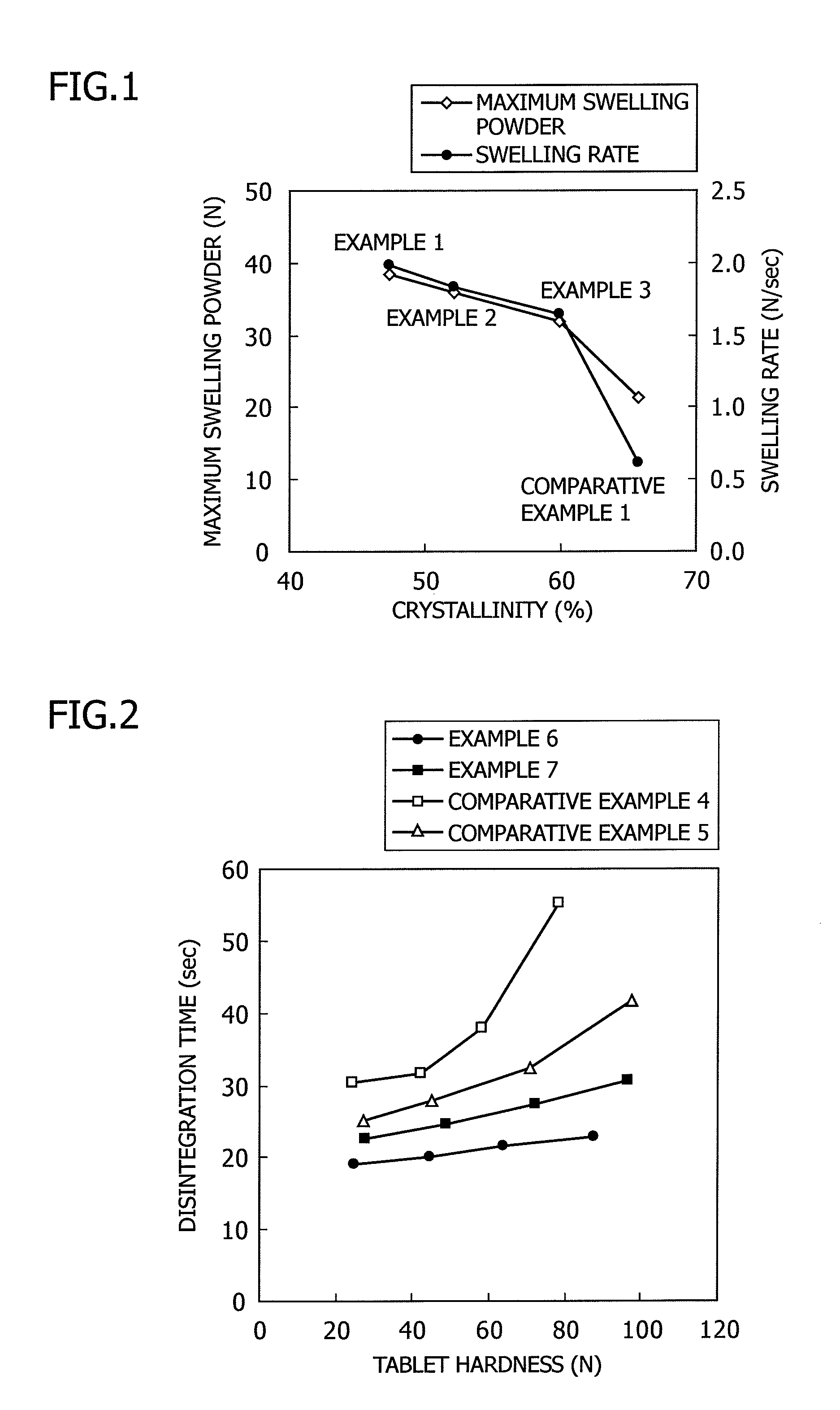Low-substituted hydroxypropylcellulose and solid preparation comprising the same
a technology of hydroxypropylcellulose and hydroxypropylcellulose, which is applied in the direction of sugar derivates, organic chemistry, chemistry apparatus and processes, etc., can solve the problems of lack of flowability, limited additives usable for them, and increasing the number of unstable drugs, etc., to achieve high flowability, high compressibility, and excellent disintegration and texture
- Summary
- Abstract
- Description
- Claims
- Application Information
AI Technical Summary
Benefits of technology
Problems solved by technology
Method used
Image
Examples
example 1
[0068]A 10-L internal stirring type reactor was charged with 829 g of pulp powder (800 g on the anhydrous basis). The reactor was further charged with 621.8 g of an aqueous 35% by weight solution of sodium hydroxide. They were mixed at 45° C. for 30 minutes to produce alkali cellulose having a weight ratio of sodium hydroxide to anhydrous cellulose of 0.272 and a weight ratio of sodium hydroxide to water of 0.502.
[0069]After nitrogen purging, 108 g (0.135 part by weight based on the anhydrous cellulose) of propylene oxide was added to the resulting alkali cellulose, followed by a reaction at a jacket temperature of 60° C. to obtain a crude reaction product of low-substituted hydroxypropylcellulose.
[0070]After 327 g of glacial acetic acid was added to 10 L of warm water in a reactor, the crude reaction product of low-substituted hydroxypropylcellulose obtained above was added thereto for neutralization. The neutralized product was then washed with hot water in a batch vacuum filter. ...
example 2
[0072]A 10-L internal stirring type reactor was charged with 829 g of pulp powder (800 g on the anhydrous basis). The reactor was further charged with 631.6 g of an aqueous 37% by weight solution of sodium hydroxide. They were mixed at 45° C. for 30 minutes to produce alkali cellulose having a weight ratio of sodium hydroxide to anhydrous cellulose of 0.292 and a weight ratio of sodium hydroxide to water of 0.547.
[0073]After nitrogen purging, 104 g (0.13 part by weight based on the anhydrous cellulose) of propylene oxide was added to the resulting alkali cellulose, followed by a reaction at a jacket temperature of 60° C. to obtain a crude reaction product of low-substituted hydroxypropylcellulose.
[0074]After 351 g of glacial acetic acid was added to 10 L of warm water in a reactor, the crude reaction product of low-substituted hydroxypropylcellulose obtained above was added thereto for neutralization. The neutralized product was then washed with hot water in a batch vacuum filter. T...
example 3
[0076]A 10-L internal stirring type reactor was charged with 829 g of pulp powder (800 g on the anhydrous basis). The reactor was further charged with 473.7 g of an aqueous 33% by weight solution of sodium hydroxide. They were mixed at 45° C. for 30 minutes to produce alkali cellulose having a weight ratio of sodium hydroxide to anhydrous cellulose of 0.195 and a weight ratio of sodium hydroxide to water of 0.451.
[0077]After nitrogen purging, 100 g (0.125 part by weight based on the anhydrous cellulose) of propylene oxide was added to the resulting alkali cellulose, followed by a reaction at a jacket temperature of 60° C. to obtain a crude reaction product of low-substituted hydroxypropylcellulose.
[0078]After 234.5 g of glacial acetic acid was added to 10 L of warm water in a reactor, the crude reaction product of low-substituted hydroxypropylcellulose obtained above was added thereto for neutralization. The neutralized product was then washed with hot water in a batch vacuum filter...
PUM
| Property | Measurement | Unit |
|---|---|---|
| particle size | aaaaa | aaaaa |
| aspect ratio | aaaaa | aaaaa |
| diffraction angle 2θ | aaaaa | aaaaa |
Abstract
Description
Claims
Application Information
 Login to View More
Login to View More - R&D
- Intellectual Property
- Life Sciences
- Materials
- Tech Scout
- Unparalleled Data Quality
- Higher Quality Content
- 60% Fewer Hallucinations
Browse by: Latest US Patents, China's latest patents, Technical Efficacy Thesaurus, Application Domain, Technology Topic, Popular Technical Reports.
© 2025 PatSnap. All rights reserved.Legal|Privacy policy|Modern Slavery Act Transparency Statement|Sitemap|About US| Contact US: help@patsnap.com

